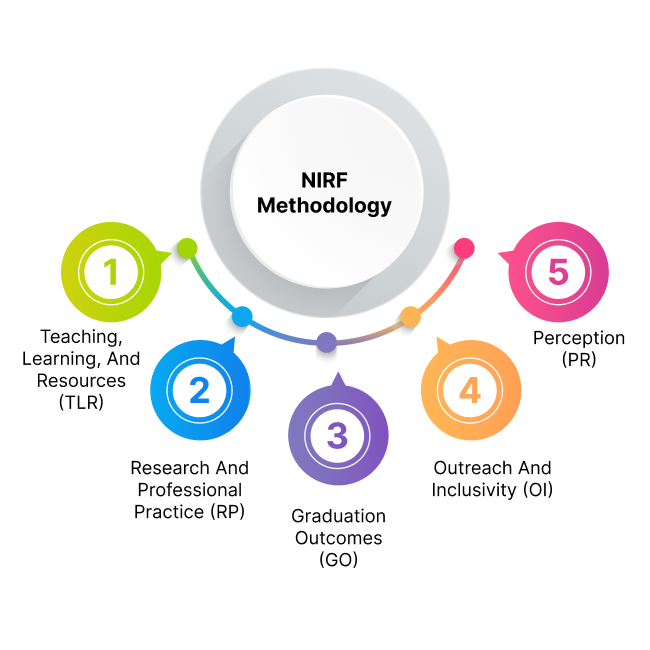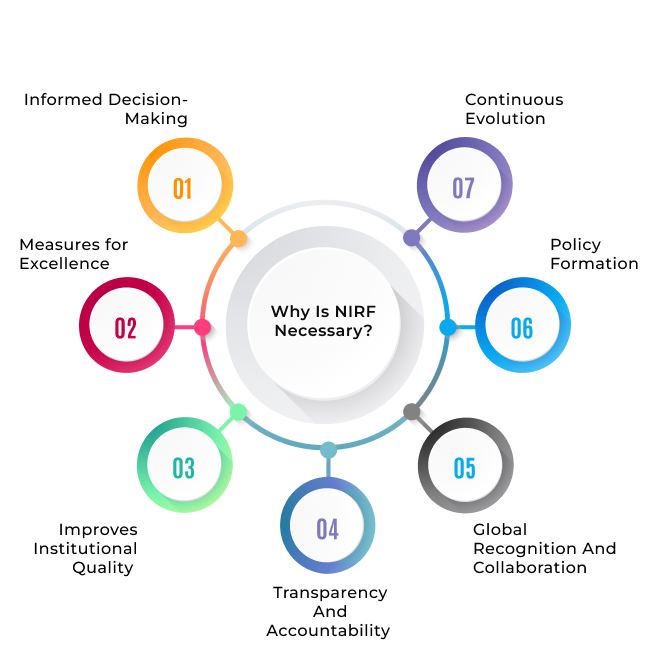22, July 2024
The three primary factors of an institute are excellent education, a continuous student support system, and an enriching learning experience. However, it can be quite challenging to maintain the quality of education, especially with the gradual expansion.
That is where the National Institute Ranking Framework acts as a motivator for implementing pre-established measures to improve core institutional functions. Furthermore, the framework provides a mechanism to assess various parameters across different domains.
What is the National Institute Ranking Framework?
The National Institute Ranking Framework is a ranking mechanism that ranks higher educational institutes according to a set of parameters. The Ministry of Human Resources Department (MHRD) launched the framework on September 29, 2015.
In fact, MHRD plays an instrumental role by setting up a core committee that conducts thorough evaluation and research of significant components. Besides, the central parameters that receive emphasis are as follows:
- Teaching, Learning, and Research (TLR)
- Research and Professional Practice (RP)
- Graduation Outcomes (GO)
- Outreach and Inclusivity (OI)
- Peer Perception (PP)
NIRF Methodology

Smooth execution of multiple institutional processes is crucial to fulfilling academic goals and organisational objectives. Therefore, transparency, standardisation, and comprehensive evaluation of different aspects of institutional performance are critical to the NIRF methodology.
As a result, institutes get a holistic view of their strengths and weaknesses, enabling them to take steps towards overcoming their shortcomings. Also, it guides stakeholders to understand and improve the quality of education.
Furthermore, the NIRF methodology incorporates several parameters, including teaching, learning, and resources; research and professional practice; graduation outcomes; outreach and inclusivity; and perception.
Also, these parameters ensure a systematic evaluation or assessment of various components in the following ways:
- Teaching, Learning, and Resources (TLR): This parameter indicates the evaluation of the quality of teaching, faculty qualifications, and teacher-student ratio. At the same time, it assesses student enrollment and the availability and utilisation of resources. For instance, it assesses the utilisation of resources such as laboratories, libraries, infrastructure, and the overall institute environment.
- Research and Professional Practice (RP): An institute’s research output, impact, quality, and productivity are the main parts of RP. Hence, it includes filed patents, published articles, collaborative projects, and funding for research activities. In fact, the main focus is on determining how the institutes make contributions in terms of research and innovation.
- Graduation Outcomes (GO): This relates to an institute’s overall effectiveness in bringing about successful graduate outcomes. Hence, it considers several significant factors, such as graduation rates, employability, placement opportunities, etc. Furthermore, it also includes the success of graduates in further education or career paths.
- Outreach and Inclusivity (OI): This particular parameter encapsulates an institute’s efforts in societal engagement, outreach activities, and inclusivity. Also, this is where NIRF takes note of the student body’s diversity. Moreover, it notes the percentage of economically challenged students and women and programmes that promote inclusivity and community engagement.
- Perception (PR): The perception parameter measures an institute’s academic and employer perceptions. More importantly, the NIRF committee collects feedback from peers, the general public, and employers. The aim of collecting feedback is to assess the institute’s reputation and status in the academic and professional worlds.
NIRF Ranking 2023 Parameters And Criteria Explained
National Institute Ranking Framework (NIRF) Ranking List
Engineering colleges, medical colleges, universities, and other domains are the main categories of institutes that are eligible for ranking. For instance, the NIRF framework assessed and ranked numerous universities throughout the country. Also, these universities cover a varied range of disciplines and offer undergraduate, postgraduate, and doctoral programmes in various fields (science, arts, commerce, engineering, management, etc.).
Engineering Colleges
The NIRF ranking list prominently covers engineering colleges that offer undergraduate and postgraduate programmes in various engineering disciplines. The evaluation process puts emphasis on parameters such as research output and academic excellence. Likewise, it places equal focus on faculty quality, infrastructure, and industry collaborations.
Medical Colleges
The framework assesses medical colleges and institutions that provide courses in medicine, nursing, dentistry, pharmacy, and allied health sciences. Besides, academic quality, clinical facilities, research output, and graduation outcomes are the main parameters for assessment.
Management Institutes
Management institutes that provide MBAs and other business-related programmes also fall under this framework. The assessment criteria for these institutes include industry interface, academic rigour, placement records, and entrepreneurial activities.
Pharmacy colleges, law colleges, and others
Apart from the above-mentioned major categories, the NIRF evaluates institutes that specialise in law, pharmacy, architecture, and other specialised fields. On the other hand, the assessment criteria for the institutes rely on specific parameters according to their respective disciplines.
Why is NIRF necessary?
NIRF’s role as an authoritative quality indicator body is to categorise institutes as per the pre-established benchmarks. At the same time, it plays a crucial role in the following ways:

1. Informed decision-making
Peer pressure, self-advertisements of institutes, and word of mouth are unreliable when it comes to selecting the right institution. Students and parents need a far more reliable and data-backed source to make their decisions. That is where the NIRF ranking facilitates the necessary platform; it provides insights into an institute’s overall performance and academic excellence. Simultaneously, it reflects the faculty quality, research output, and infrastructure. In fact, the ranking acts as a guiding tool, helping individuals make informed decisions according to their career aspirations.
2. Measures for Excellence
It becomes challenging for students or parents to make the right decision, especially when most institutes claim they are the best. Hence, an unbiased mechanism for categorising institutes on the basis of various parameters is essential. The ranking system identifies and highlights various institutes in the context of various core components. In effect, it leads to healthy competition among the higher educational institutions. Therefore, it motivates institutes to ensure continuous improvement, academic and research-related achievement, and overall institutional development.
3. Improves institutional quality
NIRF-ranked institutes receive recognition and capture students’ attention, leading to increased enrollment. Therefore, it is only fitting that institutes take the necessary steps to improve their instructional methodologies and research activities. Also, they put equal emphasis on infrastructural development and industry collaborations. Hence, it contributes to improving the overall quality of education.
4. Transparency and Accountability
Lack of favouritism or bias is key to maintaining the ranking system's integrity within the framework, which promotes transparency in the evaluation process. Furthermore, the transparency aspect creates accountability among students. As a result, institutes strive to maintain education quality and urge stakeholders to assess institutional performance from a neutral perspective.
LMS And Skill Development: Nurturing A Learning Culture
5. Global Recognition and Collaboration
One of the significant responsibilities of institutes lies in providing opportunities for students to expand their horizons. Collaborations with industry experts and other institutes and universities are key to accomplishing that aim. Having an NIRF provides a stamp of excellence, enabling institutes to attain partnerships and collaborations with international institutes. As a result, students can get access to enriching learning environments and opportunities.
6. Policy Formation
Policymakers and education authorities consider the directives of the National Institute Ranking Framework while making strategic plans and policies. Furthermore, institutes can determine their strengths and weaknesses through rankings. As a result, it enables policymakers to determine the areas that require improvement and establish policies to foster educational effectiveness.
7. Continuous Evolution
Education undergoes transformation with the changing times; therefore, the NIRF framework incorporates revisions to align with ongoing educational needs. Also, the regular methodology reviews and updates are suggestive of higher education’s changing dynamics.
Additionally, it includes continuous feedback, helping to get timely insights on the implemented changes.
Wrapping it up,
The NIRF framework is a significant system that helps to evaluate, recognise, and promote excellence in the Indian higher education system. Its yearly revision helps to impact higher educational institutes, policymakers, and students.
Furthermore, it provides a comprehensive assessment mechanism to regulate transparency, accountability, and excellence in higher education.
Still wondering what it takes to get a NIRF ranking?
Mobile: 08448010216
Email: janki.somani@iitms.co.in












